![]()
![]()
![]()
Use LEFT and RIGHT arrow keys to navigate between flashcards;
Use UP and DOWN arrow keys to flip the card;
H to show hint;
A reads text to speech;
112 Cards in this Set
- Front
- Back
|
What is a "bolus"? Where is it found? |
Glob of food generated by oral cavity that enters the esophagus by swallowing
|
|
|
What is a "chyme"? Where is it found?
|
- In stomach, food is churned in presence of digestive juices to generate a semi-fluid mass of partially digested food
- Continues to duodenum and encounters pancreatic digestive enzymes and bile from liver |
|
|
Where is digestion completed?
|
Small intestine - here the digestive products are absorbed
|
|
|
Where is water absorbed from food?
|
Large intestine- forms solid fecal material that collects in rectum
|
|
|
How does food move through the GI tract?
|
Muscular action both voluntary initially and primarily involuntary peristalsis
|
|
|
Where does voluntary movement of food through GI tract occur?
|
- Oral cavity
- Upper 1/3 of esophagus |
|
|
Where does involuntary movement of food through GI tract occur?
|
Below upper 1/3 of esophagus
|
|
|
What are the four layers of the GI tract?
|
- Mucosa
- Submucosa - Muscularis externa - Adventitia / Serosa |
|
|
What is the innermost layer of the GI tract?
|
Mucosa
|
|
|
What are the components of the mucosa?
|
- Epithelium
- Lamina Propria (LP) - Mucularis Mucosa (MM) |
|
|
What types of epithelium are found in the mucosa layer of the GI tract?
|
Varies depending on function
- Stratified squamous - Simple columnar |
|
|
What is the function of the Lamina Propria? Which layer is it in?
|
- Loose CT that supports the epithelium
- Rich in lymphatic and blood capillaries - Immune functions - contains lymphocytes and plasma cells - Mucosa |
|
|
What muscular layer is found in the mucosa? Function?
|
Muscularis Mucosa (MM) - thin layer of smooth muscle required for local movements of mucosa and controlling the folding of the mucosa
|
|
|
What layer is below the mucosa? Function?
|
Submucosa - structural support to mucosa
|
|
|
What is the submucosa composed of?
|
- Loose collagenous and adipose tissue
- Large blood vessels and lymphatic vessels - Mucous secreting glands (in esophagus and duodenum) - Nervous tissue |
|
|
Where are there mucous secreting glands in the submucosa? Function?
|
- Esophagus
- Duodenum - Important to keep things moving? |
|
|
What nervous tissue is found in the submucosa? Function?
|
Submucosal / Meissner's Plexus - parasympathetic ganglia that controls muscularis mucosa movement, blood flow, and gland secretion
|
|
|
Where is Submucosal / Meissner's Plexus found? Function?
|
Submucosa - controls muscularis mucosa movement, blood flow, and gland secretion
|
|
|
What is the layer below the submucosa? Function?
|
Muscularis Externa - mixes luminal contents and propels contents along the GI tract
|
|
|
Where is the muscularis externa missing in the GI tract?
|
Esophagus and Anal Sphincter (contain skeletal muscle)
|
|
|
How is the muscularis externa arranged?
|
- Inner C(i)rcular layer
- Outer L(o)ngitudinal layer - Important for peristalsis |
|
|
What nervous tissue is found in the Muscularis Externa?
|
Myenteric (Auerbach's) Plexus - resides between muscle layers and controls peristalsis
|
|
|
What outermost layer protects the GI tract?
|
Adventitia / Serosa
|
|
|
What is the Adventitia made of? Location?
|
- Loose CT layer surrounding GI tract
- OUTSIDE peritoneal cavity |
|
|
What is the Serosa made of? Location?
|
- Simple squamous epithelium (mesothelium) allong w/ CT
- WITHIN peritoneal cavity |
|
|
What is the function of the epithelial component of the Adventitia / Serosa?
|
Secretes serous fluid to lubricate the interface between the visceral and parietal peritoneum allowing movement of GI tract organs
|
|
|
How many neurons are in Enteric NS?
|
~100 x 10^6 neurons
|
|
|
What part of the NS is the Enteric NS a part of?
|
Division of the ANS but can operate independently of the brain and spinal cord ("second brain")
|
|
|
What regulates the ENS?
|
Hormones secreted by enteroendocrine cells
|
|
|
How do enteric neurons mediate their action?
|
NTs and neuromodulators found in brain (ACh, NE, and serotonin)
|
|
|
How do the PNS and SNS affect the GI?
|
- PNS - stimulates secretion and peristalsis
- SNS - represses peristalsis and activates activity of sphincters |
|
|
What is the function of the Submucosal (Meissner's) Plexus?
|
Controls mucosal movement, secretory activity and blood flow
|
|
|
What is the function of the Myenteric (Auerbach's) Plexus?
|
Controls peristaltic gut movements
|
|
|
What are the mucosa types that vary throughout the GI tract depending on function?
|
- Protective
- Secretory - Absorptive - Absorptive / Protective |
|
|
What kind of epithelium has a Protective function? Location?
|
- Stratified squamous epithelium
- Mainly found in the upper G.I. and anus. |
|
|
What kind of epithelium has a Secretory function? Location?
|
- Found in the stomach
- Contains an abundance of tubular glands |
|
|
What kind of epithelium has a Absorptive function? Location?
|
- Folded into villi to maximize surface area
- Found throughout the small intestine |
|
|
What kind of epithelium has a Absorptive / Protective function? Location?
|
- Lines the large intestine
- Produces mucin to help fecal movement and absorbs water |
|
|
What are the components of the Esophagus Mucosa?
|
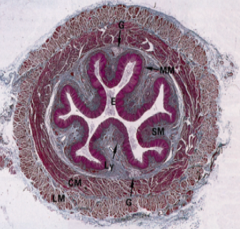
- Epithelium
- Lamina Propria - Muscularis Mucosa |
|
|
What are the characteristics of the Epithelium in the Esophageal Mucosa?
|
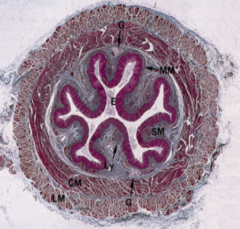
- Stratified, non-keratinized squamous epithelium
- Contains Langerhans cells (APCs) |
|
|
What are the characteristics of the Lamina Propria in the Esophageal Mucosa?
|
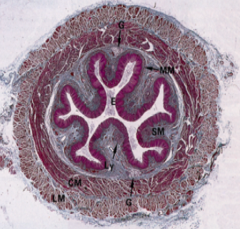
- Narrow, w/ lymphoid aggregates
- 2 clusters of mucosal glands that secrete mucous to help propel food = esophageal cardiac glands |
|
|
What are the characteristics of the Muscularis Mucosa in the Esophageal Mucosa?
|
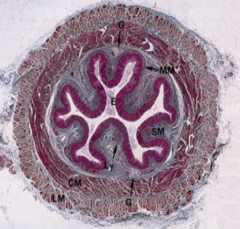
- Difficult to identify because it consists of a single layer of smooth muscle cells
- More substantial near stomach |
|
|
What are the characteristics of the Submucosa in the Esophagus?
|
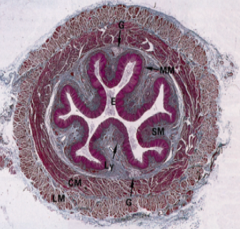
- Esophageal glands (G) are abundant
- Arranged as Acini that drain into a central duct similar to salivary glands - Contains two cell types: mucous cells and serous cells |
|
|
What are the two types of cells in the Submucosa of the Esophagus? Distinctions?
|
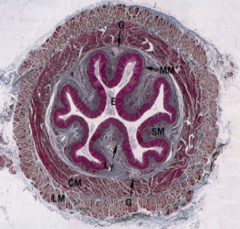
- Mucous cells - basally located nucleus (more abundant)
- Serous cells - centrally located nucleus (less abundant) |
|
|
What are the major secretory products of the serous cells in the Submucosa of the Esophagus?
|
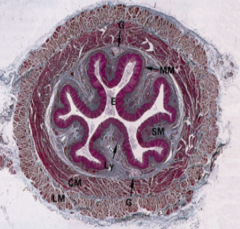
- Pepsinogen
- Lysozyme - Deposited via ducts into the lumen |
|
|
What are the characteristics of the Muscularis Externa in the Esophagus?
|
- Inner layer of circular smooth muscle (CM)
- Outer layer of longitudinal smooth muscle (LM) - Upper 1/3rd of the esophagus has skeletal muscle (Sk) interspersed with the smooth muscle - Initial swallowing is under voluntary control and so utilizes skeletal muscle |
|
|
What are the characteristics of the Adventitia / Serosa in the Esophagus?
|
- Prior to reaching the diaphragm, the esophagus is encased with an adventitia
- Once it traverses the diaphragm, it is covered with a serosa |
|
|
What happens to the epithelium at the Gastroesophageal junction?
|
- Esophagus: stratified squamous epithelium
- Stomach: simple columnar epithelium (dedicated to secretion) |
|
|
What kind of sphincters are in the esophagus?
|
- No anatomical sphincters (visible)
- Two physiological sphincters (pharyngoesophageal sphincter and gastroesophageal sphincter) |
|
|
What is the function of the pharyngoesophageal sphincter? Type?
|
- Prevents reflux from esophagus into pharynx
- Physiological sphincter (not visible) |
|
|
What is the function of the gastrooesophageal sphincter? Type?
|
- Prevents reflux from stomach into esophagus
- Physiological sphincter (not visible) |
|
|
What happens in the stomach?
|
Food undergoes mechanical and chemical digestion to form chyme
|
|
|
How are the mucosa and submucosa arranged in the stomach?
|
Arranged as folds called "rugae" in empty stomach
|
|
|
How much can the stomach contain? How?
|
Holds ~1.5 L by distending the rugae (folds)
|
|
|
What are the components of the gastric juice?
|
- HCl
- Digestive enzymes: pepsin, rennin, and gastric lipase |
|
|
What are the four anatomical regions of the stomach?
|
- Cardia
- Fundus - Body (corpus) - Pyloris |
|
|
What is the small area of the stomach found at the gastroesophageal junction?
|
Cardia
|
|
|
What is the area of the stomach found to the upper left of the cardia? Function?
|
Fundus - secretes acid and enzymes
|
|
|
What is the central area of the stomach? Function?
|
Body (corpus) - secretes acid and enzymes
|
|
|
What is the constriction region at the base of the stomach? Function?
|
Pyloris - regulates the release of chyme into the duodenum (pyloric sphincter), also secretes gastrin
|
|
|
Where is gastrin secreted in the stomach? Acid? Enzymes?
|
- Gastrin - pyloris
- Acid and enzymes - fundus and body/corpus |
|
|
What are the characteristics of the Epithelium in the Stomach Mucosa?
|
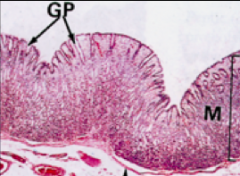
- Simple columnar epithelium
- Generate a thick mucous (visible) covering that traps bicarbonate ions (alkaline) and protects the mucosa from the low pH in stomach - Soluble mucous also acts as a lubricant - Invaginates into the lamina propria forming Gastric Pits (GP) |
|
|
What is the function of the thick mucous covering the epithelium of the stomach?
|
- Traps bicarbonate ions (alkaline)
- Protects mucosa from low pH in stomach - Acts as lubricant |
|
|
What are the characteristics of the Lamina Propria in the Stomach Mucosa?
|
- Loose CT layer densely packed w/ gastric glands
- Enterochromaffin-type cells secrete histamine in response to vagus nerve to increase acid secretion |
|
|
What do Enterochromaffin-type cells secrete? Location? Function?
|
- Histamine in response to vagus nerve to increase acid secretion
- Found in lamina propria of the stomach mucosa |
|
|
What are the characteristics of the Muscularis Mucosa in the Stomach Mucosa?
|
- Smooth muscle
- Gastric glands extend to MM - Influences gastric gland outward flow |
|
|
What are the characteristics of the Stomach Submucosa?
|
- Thick layer of dense connective tissue
- Numerous wandering cells including lymphocytes, eosinophils, mast cells, and plasma cells, may also have adipose cells - Vascular and lymphatic structures - Submucosal (Meissner’s) plexus |
|
|
What are the characteristics of the Stomach Muscularis Externa?
|
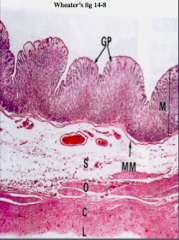
Three layers of smooth muscle (O, C, L):
- Circular and longitudinal always present - Oblique fibers may also be present |
|
|
What controls the contraction of the Stomach Muscularis Externa?
|
Myenteric (Auerbach's) Plexus between layers
|
|
|
What are the indentations in the mucosa of the stomach?
|

Gastric Pits
|
|
|
What is the organization of Gastric glands?
|

- Tubular columns of epithelial cells
- 1-7 gastric glands open into each gastric pit |
|
|
What are the regions of the gastric glands? Distinctions?
|
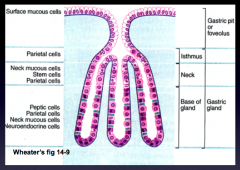
3 regions:
- Isthmus - Neck - Base * Different epithelial cell types in each region |
|
|
What are the 6 cell types in the gastric glands?
|
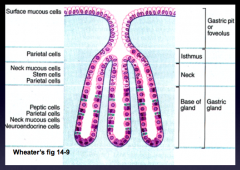
1. Surface mucous/lining cells (gastric pit)
2. Parietal (oxyntic) cells (isthmus, neck, and base) 3. Neck mucous cells (neck and base) 4. Chief (zymogenic, peptic) cells (base) 5. Enteroendocrine cells (base) 6. Stem (regenerative) cells (neck) |
|
|
Where are the surface mucous / lining cells found in the gastric gland?
|

Gastric Pit
|
|
|
Where are the parietal (oxyntic) cells found in the gastric gland?
|
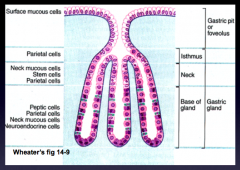
Isthmus, neck, and base
|
|
|
Where are the neck mucous cells found in the gastric gland?
|
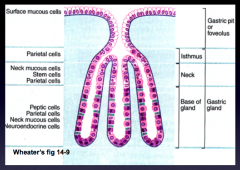
Neck and base
|
|
|
Where are the enteroendocrine cells found in the gastric gland?
|

Base
|
|
|
Where are the stem (regenerative) cells found in the gastric gland?
|
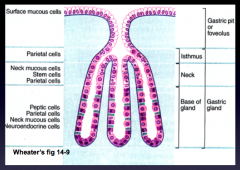
Neck
|
|
|
What are the properties of the mucous secreted by surface lining cells? Function?
|
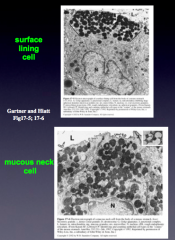
- Thick and dense mucous
- Adheres to mucosa and protects against acid digestion |
|
|
What are the properties of the mucous secreted by mucous neck cells? Function?
|

- Soluble mucous
- Lubricates the stomach contents to aid digestion |
|
|
Which cells in the stomach secrete thick/dense mucous that adheres to the mucosa and protects against acid digestion?
|
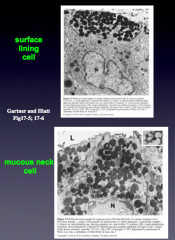
Surface lining cells
|
|
|
Which cells in the stomach secrete soluble mucosa and lubricates the stomach to aid in digestion?
|
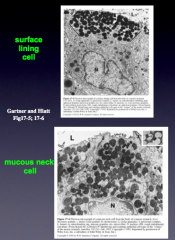
Mucous neck cells
|
|
|
What are the subtypes of enteroendocrine cells? What do they secrete?
|
- G cells - gastrin
- EC cells - serotonin - D cells - somatostatin - A cells - enteroglucagon - ECL cells - histamine |
|
|
What is the shape of the entroendocrine cells? Location?
|
Small ovoid or pyramidal cells between the base of neighboring epithelial cells (detected by immunostaining)
|
|
|
What is the function of the enteroendocrine cells?
|
- Release products, which are stored as granules, into the lamina propria
- Substances act either on surrounding cells in Paracrine fashion or are transported through bloodstream to act in Endocrine fashion |
|
|
What is the function of Parietal cells in the stomach?
|
Generate HCl and Gastric Intrinsic Factor
|
|
|
How do you identify parietal cells in the stomach?
|
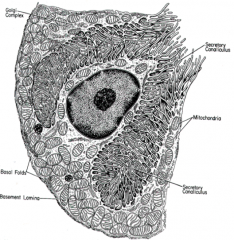
- Identified within gastric glands because their cytoplasm stains heavily with eosin
- Pyramidal cells distinctive d/t present of an invagination of apical surface called the secretory canaliculus, which can almost encircle the nucleus - Dense microvilli extend into canaliculus |
|
|
What is the term for the invagination on the apical surface of the parietal cells?
|
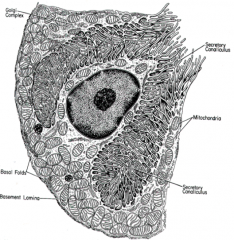
Secretory Canaliculus (can almost encircle the nucleus)
|
|
|
What feature is found on the Secretory Canaliculus of the Parietal cells? Function?
|
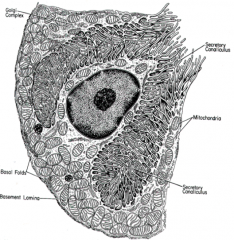
Dense network of microvilli - increases the secretory surface area of the cell
|
|
|
What feature of a parietal cell inversely correlates with the HCl secretion?
|
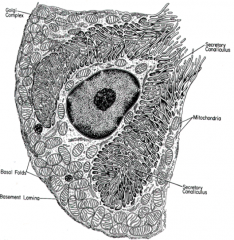
Tubulovesicular network - unique ultrastructural feature
|
|
|
What organelle are Parietal Cells abundant with? Why?
|
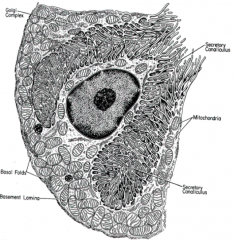
Extremely rich in mitochondria - provides energy for HCl secretion
|
|
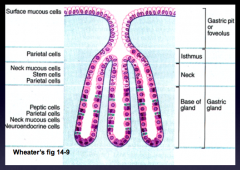
What is the principal cell type at the base of the gastric glands?
|
Chief Cells
|
|
|
What is the function of the Chief Cells? Location?
|
- Secrete digestive enzymes into the stomach lumen
- Found at the base of the gastric glands |
|
|
What do Chief Cells contain?
|
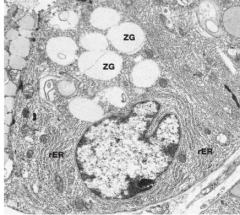
- Zymogen secretory granules (ZG) at apical end, which contain proenzymes
- Basal nucleus |
|
|
What is found within the Zymogen Secretory Granules (ZG) at the apical side of Chief Cells?
|
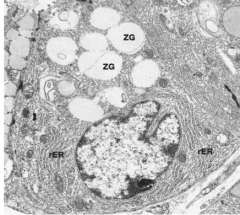
Proenzymes:
- Pepsinogen - Rennin - Gastric Lipase |
|
|
What organelles are prominent in Chief Cells? Why?
|
Packed with RER and Golgi to accomplish high volume protein production
|
|
|
What controls the Zymogen Secretory Granule (ZG) release from the Chief Cells?
|
Granule release is controlled by both hormonal and neural action:
- Binding of the hormone Secretin to the receptors leads to rapid exocytosis of secretory granules - Neural stimulation (more significantly) via the Vagus Nerve also results in enzyme release |
|
|
How common are stem cells in the stomach? Where are they found?
|
- Few in number
- Most commonly found in the neck of the gastric gland |
|
|
How often are the cells of the gastric mucosa turned over? What determines this?
|
- Completely renewed every 3 days
- Depends upon proliferating stem cell compartment |
|
|
How can you identify stem cells in the stomach?
|
Contain mitotic figures in stained sections
|
|
|
What happens as the stem cells divide in the neck of the gastric glands in the stomach?
|
Daughter cells differentiate an migrate upward or downward to replace all types of epithelial cells
|
|
|
How is the surface epithelium of the stomach repaired after injury (eg, aspirin)?
|
Rapidly, by migration of epithelial cells lying deep in the protected environment of the pits - mucosal restitution
|
|
|
How does the mucosa differ in the different areas of the stomach?
|
- Fundus and Body - histologically indistinguishable w/ straight tubular glands
- Pylorus - contains same cell types as other regions, however glands are branched and mucous neck cells predominate - Cardia - shallower gastric pits and glands are highly coiled, abundance of enteroendocrine cells |
|
|
What are the features of the mucosa of the fundus of the stomach?
|
Histologically indistinguishable from body of stomach w/ straight tubular glands
|
|
|
What are the features of the mucosa of the body of the stomach?
|
Histologically indistinguishable from fundus of stomach w/ straight tubular glands
|
|
|
What are the features of the mucosa of the pylorus of the stomach?
|
Contains same cell types as other regions, however glands are branched and mucous neck cells predominate
|
|
|
What are the features of the mucosa of the cardiac region of the stomach?
|
Shallower gastric pits and glands are highly coiled, abundance of enteroendocrine cells
|
|
|
What are the phases in the stomach in response to a meal?
|
1. Cephalic Phase
2. Gastric Phase 3. Intestinal Phase |
|
|
What is the first stage in the stomach in response to a meal? What happens?
|
Cephalic Phase
- Brain anticipates a meal via smells and visual cues - PNS signals via vagus nerve → ACh → acts on G cells → secretes Gastrin - Gastrin, ACh, and Histamine act on Parietal cells → stimulates limited HCl release (30%) |
|
|
What is the second stage in the stomach in response to a meal, after the cephalic phase? What happens?
|
Gastric Phase
- Food enters stomach → distension → increased G cell activity - Increased gastric juice release (60% HCl release) - Onset of powerful smooth muscle contraction → mechanical digestion |
|
|
What is the third stage in the stomach in response to a meal, after the gastric phase? What happens?
|
Intestinal Phase
- Chyme released into duodenum - Gastric emptying slows - Distension of intestine → gastric-inhibitory impulses by ENS = Enterogastric Reflex - Cholecystokinin (CCK) and Secretin suppress gastric activity (10% HCl release) |
|
|
During what phases of the stomach's response to a meal does HCl get secreted, how much?
|
1. Cephalic Phase (30%)
2. Gastric Phase (60%) 3. Intestinal Phase (10%) |

